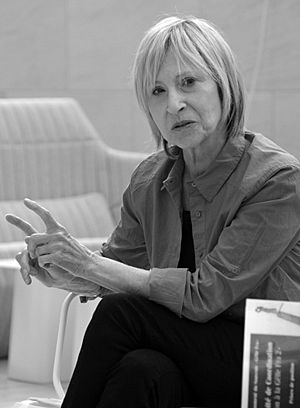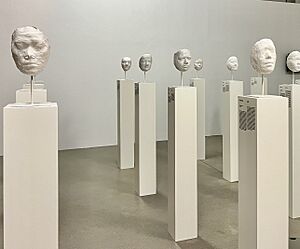Sanja Iveković facts for kids
Sanja Iveković (born in 1949 in Zagreb) is a famous Croatian artist. She creates art using photography, performances, sculptures, and installations. Her art often explores ideas about what it means to be a woman, how media influences us, and how society uses products. She also looks at big political issues. Many people see her as one of the most important artists from the area that used to be Yugoslavia. She still inspires many young artists today.
Contents
Early Life and Art Career
Sanja Iveković was born in Zagreb in 1949. At that time, Zagreb was part of Yugoslavia, led by Marshal Josip Broz Tito.
She studied art at the Zagreb Academy of Fine Arts from 1968 to 1971. Her art journey began in the early 1970s during a time called the Croatian Spring. She and other artists started new ways of making art, like using video, photo collages, and performances.
Much of her art focuses on her own life and the role of women in society. She was the first artist in Croatia to call herself a feminist artist. This means her art supports equal rights and opportunities for women. She has been very involved with the Centre for Women's Studies in Zagreb since it opened in 1994.
Iveković also works outside of her art to help women. She has helped start or worked with many Croatian women's groups. These include ELEKTRA-Women's Art Center and B.a.B.e.. In 2023, she started the Sanja Iveković Institute (ICI).
Exploring Women's Roles in Art
Since she started her career, Iveković has always been interested in how women are shown in society.
Early Artworks and Media
Some of her early works include "Double Life" (1975). In this project, she put 66 photos from her own life next to similar pictures of models from magazines. "Make Up-Make Down" (1978) featured self-portraits she filmed or photographed. "General Alert: Soap Opera" (1995) was made for television.
In "Figure & Ground" (2006), she made collages of female models. These models looked like armed fighters, covered in blood, and wearing military-style clothes from famous designers.
Challenging Society with Art
In 1982, her artwork Personal Cuts was shown on national television in Yugoslavia. In this piece, Sanja Iveković questioned the official stories of the government. She mixed old videos of big public events and speeches by Tito with scenes of herself. In these scenes, she cut holes into a black stocking over her face. This looked like a homemade mask and showed a quiet act of standing up for herself.
"Women's House" is a project she started in 1998 and still works on. It shows plaster casts of the faces of women who have experienced harm. These faces are arranged in a half-circle. "Women's House (Sunglasses)" is a series of posters and magazine ads. It brings attention to the issue of harm against women in Croatia.
Memorials and Public Art
At the 2010 Gwangju Biennale, Iveković created "On the Barricades." This was a living memorial for the Gwangju people's uprising on May 18, 1980. It was based on her earlier work, "Rohrbach Living Memorial" (2005). That piece showed the story of the Roma who were victims of the holocaust. For "On the Barricades," volunteers acted as statues of the victims. They were surrounded by screens showing photos of 545 victims. The artist intentionally closed the eyes of the people in the photos.
In 2017, at an art show called documenta 14, Sanja Iveković rebuilt part of an old monument from 1926. She used old bricks in a public square in Athens. This made people think about how cities remember political events. She also held a live event there with artists and activists. They talked about creating a new movement for fairness and women's rights. It was a strong mix of history, feminism, and public action.
Lady Rosa of Luxembourg
One of Iveković's most famous artworks is "Lady Rosa of Luxembourg." She has said that her work since the 1970s has focused on three main ideas: gender, identity, and memory. She explained that as an artist, she looks at how women are shown in everyday life through media. As a feminist, she tries to make art that shows her beliefs about being a woman in a society where men often have more power.
The Sculpture and Its Impact
In 2001, Iveković made a copy of Luxembourg's national symbol, the Gëlle Fra (Golden Lady) statue. She made her version of the woman look pregnant and named her after Rosa Luxemburg, a famous activist. She also changed the words on the plaque next to the statue to say: "..., ..., MADONNA, VIRGIN."
This new statue was placed near the original one for a while. It caused a lot of upset. People were most angry about the words on the plaque. Some even called for Luxembourg's minister of culture to resign.
The "Lady Rosa" sculpture was shown again at the Museum of Modern Art in 2011. A writer for The New York Times, Roberta Smith, wrote about it. She said the artwork caused a big stir when it was first shown in Luxembourg. This was partly because it was in a public park, close to the original statue that looked almost the same but was not pregnant. News clippings and TV interviews showed how much attention it received. Smith noted that "Lady Rosa" acted like a "lightning rod," meaning it drew a lot of strong reactions. In one TV interview, a young man pointed out that people were more offended by the words on the statue's base than by the fact that many women and children face harm every day.
Awards and Recognition
In 2009, Iveković won the Camera Austria Award. This award recognized how important photography is in her art. The judges noted that her work was very current and important for younger artists. They also praised her efforts to improve the role of women in society through works like "Women's House."
In 2014, she was chosen as a finalist for the Artes Mundi prize. She showed her photography-based works, GEN XX (1997–2001) and The Disobedient (The Revolutionaries). These were displayed at the Turner House Gallery in Penarth, Wales.
Selected Exhibitions
- SC Gallery, Zagreb, 1970
- Triangle, Savska 1, Zagreb, 1979
- Town-Crier, Franklin Furnace, New York, 1982
- Manifesta 2: European Biennial of Contemporary Art, Luxembourg, 1998
- "Sanja Iveković: Personal Cuts," Galerie im Taxispalais, Innsbruck, Austria, 2001
- 10,000 Lives, Eighth Gwangju Biennale, South Korea, 2010
- Sanja Iveković: Sweet Violence, MoMA, New York, 2011–2012
- Sanja Iveković: Unknown Heroine, South London Gallery & Calvert 22, London, 2012–2013
- Sanja Iveković: WORKS OF HEART (1970.-2023.), MSU, Zagreb, 2023
- The Visible ones (Vidljive), MSU, Zagreb, 2023
See also
 In Spanish: Sanja Iveković para niños
In Spanish: Sanja Iveković para niños



